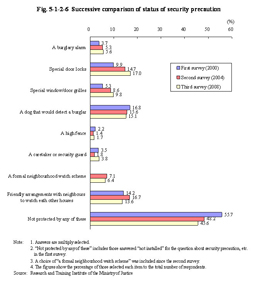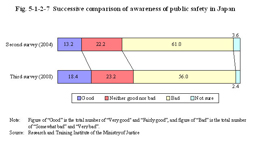| Previous Next Index Image Index Year Selection | |
|
|
3 Fear of crime/security precautions/awareness of public safety in Japan (1) Fear of crime As revealed in Fig. 5-1-2-5 fear of crime was the lowest in percentage in the first survey (2000), rose in the second survey (2004), but declined slightly in the third survey (2008). The number of cases reported for penal code offenses had been decreasing for five consecutive years until 2007 after reaching a post World War II high in 2002. Familiar crimes such as injuries, burglary, and damage to property, which are considered to affect fear of crime at a relatively large scale, have been on a slightly decreasing trend since 2004. Unlike the overall trends, however, they still remain at a high level and the number of cases reported for assault has been increasing since 1999 (see Fig. 1-1-2-2 in Part 1, Chapter 1). For this reason, improvement in fear of crime has remained negligible. Fig. 5-1-2-5 Successive comparison of fear of crime a. Feeling safe/unsafe on the street alone after darkTo the question “How safe do you feel when walking alone in your area after dark?”, the answers of “very safe” and “fairly safe”, which had decreased in the second survey, improved slightly in the third survey while “very unsafe” and “bit unsafe” decreased slightly in percentage (Fig. 5-1-2-5 [1]). b. Feeling safe/unsafe at home alone after dark To the question “How safe do you feel when being at home alone after dark?”, the percent ratio of those answering “very safe” declined by 8.7 points while that of those answering “bit unsafe” rose to take that percentage over in the second survey. In the third survey the percent ratio of those answering “very safe” increased by 3.5 points from the second survey while that of those answering “bit unsafe” declined by 2.0 points (Fig. 5-1-2-5 [2] c. Thinking burglary is likely/not likely To the question “What would you say are the chances that over the next twelve months someone will try to break into your home?”, the percent ratio of those answering “not likely” in the third survey rose by 6.2 points from the second survey while that of those answering “likely” and “very likely” declined accordingly (Fig. 5-1-2-5 [3]). (2) Security precaution With regard to the status of security precaution, trends that were remarkable in the first survey through to the third survey included the rise in the rate of homes/residents protected by [1] burglary alarms, [2] special door locks, and [3] special windows/door grilles and the decline in the ratio of those answering “not protected by any of these” (Fig. 5-1-2-6). Fig. 5-1-2-6 Successive comparison of status of security precaution (3) Awareness of public safety in JapanWith regard to awareness of public safety in Japan, which summarizes the above, the percent ratio of those answering “good” rose in the third survey by 5.2 points from the second survey while those answering “bad” declined by a similar percentage (Fig. 5-1-2-7). However, those answering “bad” still accounted for the majority in the third survey, thus indicating that public awareness of public safety is still rather severe. Fig. 5-1-2-7 Successive comparison of awareness of public safety in Japan |


